Kampen Course at Purdue University
by David Stewart
October 2011
“As a person who calls Indiana home, I am very pleased to have had the opportunity to build one of the finest university golf courses in the country at Purdue.” ~Pete Dye
In 1994, the North Course at Purdue University was the weaker of the two layouts. The Bill Diddle designed South Course (named Ackerman Hills) and site of Jack Nicklaus’s 1961 NCAA championship was much more revered. An upcoming road construction project was going to cause needed changes to the routing of the North Course, and Purdue consulted Pete Dye to see what could be done. The simple renovation became a full scale reconstruction as the building of a completely new course began in 1996.
The course was to serve as both a test to the collegiate golfer and as a classroom for students. The departments of Forestry, Entomology, Water Quality Testing, Agronomy and other schools at Purdue all became involved. The course uses a breakthrough water reclamation system in which all water used is recycled. All water that goes through the course is tested and analyzed. More about this can be found here (http://www.agry.purdue.edu/turf/report/2001/page44-46.pdf) including a schematic of the constructed wetlands and drainage system.
The course opened in 1998 and is scattered with waste bunkers and heather, with very few trees actually in play. It is often windy which makes playing from day to day all the more enjoyable. Lindberg Road passes through the middle of the course, and nine holes are on one side and nine are on the other, although not all are on the same nine. With the options Mr. Dye had to work with, the course is routed very well. The inevitable four passes under the road make the walk slightly more cumbersome, although none of these are more than a couple hundred yards.

An early routing scheme of the course. While not all the holes were designed as this shows, they are all still in the indicated position.
The course is consistently ranked among the best university courses and was named one of the seven courses on the Pete Dye Golf Trail (established 2011), which highlights his great work in Indiana. Kampen was the host of the 2008 Division I NCAA Championship which saw the highest winning team score posted in over 30 years. The winds were often in the 20-30 mph range with gusts higher than that, and the rough was not mown for about two weeks before the tournament, which led to the high scores. There are five total tee boxes with the tips measuring a challenging 7465 and the fronts at 5260. The middle set (whites) is played by most and measures 6411. That being said, the course is difficult for high handicappers and selection of the proper tee boxes is an important consideration before the round. It has sometimes been said you should choose the box you think you can play from and then move up. It would be difficult to take your family here and enjoy a round, as waste bunkers, tall grass, and water hazards provide many opportunities to lose balls after wayward shots. However, for those who can play a little bit, strategy abounds throughout the round and deciding on the proper way to navigate each hole never gets old.
Holes to Note:
#1 – par 4 (392 Tips/365 Whites):
Dye gives you a relatively easy hole for the first to get settled into the round. The green favors a right-to-left approach and is guarded by a bunker on the left side with run up approaches possible from the right. The tee shot is where the real strategy comes into play. A large waste bunker down the right crosses into the right side of the fairway about 130 yards from the hole until about 90-100 yards out. You can hit a hybrid or fairway wood up the right side of the fairway to leave a 150 yard approach with a good angle but slightly blind, drive left and long to the narrow part of the fairway to leave a short approach with a poorer angle, or for the long hitter, attempt to carry the cross bunker completely and leave a short pitch into the green. A strategy-filled first hole gives the golfer a taste of what to expect for the next few hours.

From the right side of the fairway, the flag is just visible between the tall grasses below the golfers on the second tee, but…

Conversely, this approach from the left side leaves a clear view of the green but requires a carry over the bunker.
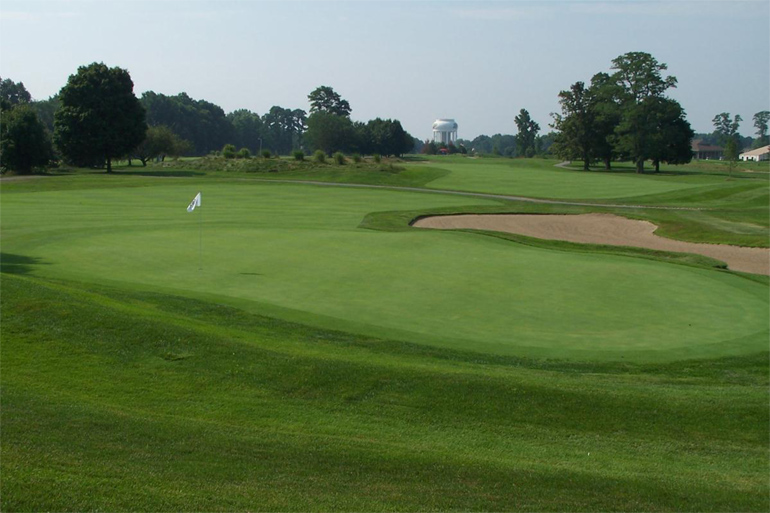
From behind the green, one can see how the fairway narrows up the left for those choosing to attack with a driver.
#4 – par 5 (534/478):
A great risk/reward par 5, this hole provides the best chance of all the three shotters to get home in two. A waste bunker guards the left and misses to the right will be below the level of the fairway. The fairway drops off into a valley at about 80 yards out before the green rises up again so a good lay-up should leave about 100 yards. Those attempting to go for the green are faced with one of the smaller greens on the course that sits up on a knoll with bunkers front and right and a large collection area left and well below the green. Many times a golfer will miss the green left to avoid the bunkers and tall grass on the right. The challenge is that this area is tightly mown, leaving an uphill shot from a tight lie to a crowned green where the surface is not visible. A great example that short grass can be a hazard!

Those attempting to reach in two who bail out short and left will be left with this ticklish pitch up to the green.
#6 – par 5 (598/553):
One of the most visually appealing holes on the course, the challenge is right in front of you when standing on this elevated tee box. The hole doglegs to the right around the celery bog, with the green visible all the way on the other side. A large waste bunker guards the right side of the fairway on the inside of the bog, and the sight of the green in the distance to the right seems to draw balls towards this bunker. Those trying to get home in two will have to carry a large bunker that starts at about 100 yards out in the right fairway and continues all the way up the right side of the green. This shot must also be left-to-right to run up to or hold the green, which is very narrow from this angle. Those laying up at about 100 yards will have a simple approach down the length of the green, which is one of the more undulating on the course.

Part of the driving area is visible left of the large waste bunker. The green is across the water almost directly above the right tee marker. The flag visible in the distance is probably 60 degrees right of the landing zone, and causes many a golfer to push their tee ball into the bunker or even the bog.

From behind, one can see that going for the green in two requires a long carry over the fairway bunker to a green that is very skinny from that angle. A layup to the fairway in the right portion of the picture leaves an approach with a much better look at the green. Dye’s masterful use of playing angles is once again fully evident here.
#7 – par 4 (365/290):
It is always enjoyable to see the face of a first-time player of Kampen when he or she arrives on this hole. Two separate fairways greet the golfer with a massive waste area in between. The green complex is surrounded by closely mown grass, giving the long hitter the option of driving over the waste area and on or through the green. What does the golfer do off the tee; drive the green, draw up the right fairway, fade up the left fairway, fairway wood, iron? Pin position should be considered on the tee as this large, undulating green can leave a tough pitch if coming from the far fairway.
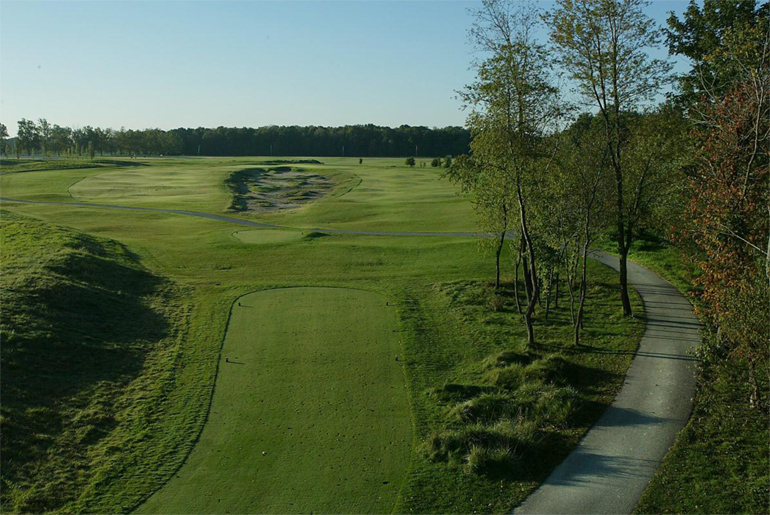
The two fairways and drivable green give the golfer many options from the tee. The green is directly over the large center waste area.

From behind the large, undulating green, one gets a sense of the challenge the golfer faces if he or she is off target on the drive or approach.
#8 – par 4 (406/367):
This dogleg right two shotter can be played a couple different ways. The conventional and usual path is a fairway wood over the hill to the blind landing zone, which will leave a short to mid-iron approach. However, the bold player can challenge the bunker down the right with a driver to leave only a wedge. A lone, small pot bunker that fronts the center of the green dictates play on the approach.
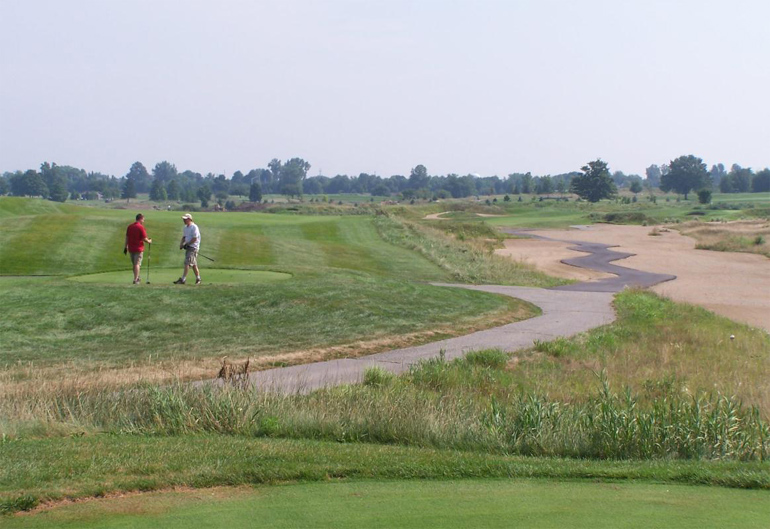
The green is barely visible on the far right of the picture. There is plenty of room for a fairway wood over the hill, or the long hitter can challenge the bunker right with a driver.
#9 – par 4 (478/392):
A classic Pete Dye “switch-back” hole, where a draw is favored off the tee and a fade on the approach. This hole has a large waste bunker down the left side of the landing zone, and a large drop off from the fairway on the right. If one can draw their tee shot and hit it well, he or she will be rewarded with some extra distance as the fairway slopes down about 240 yards from the tee. The big hitter can attempt to carry the bunker on the left, leaving the ideal angle to the green. A large bunker on the right side of the green and mounded, tightly mown short grass on the left await errant shots. This 50 yard deep green allows for many hole locations.
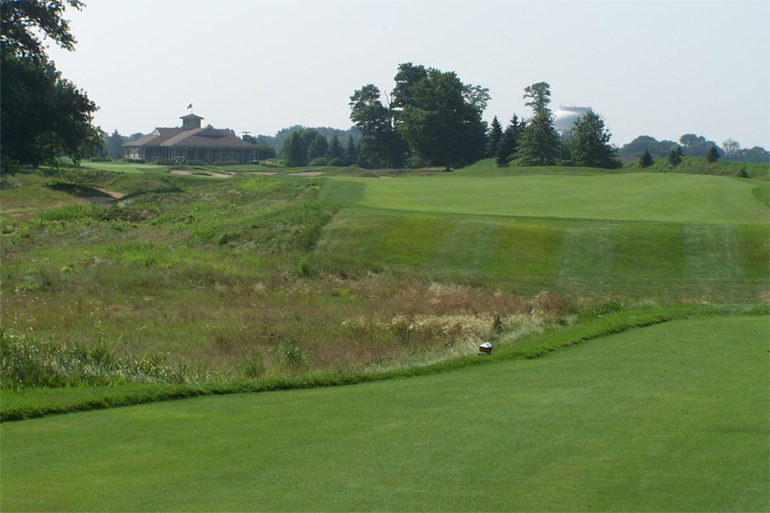
A tee shot moving right-to-left around the waste area gives the best chance to hold the fairway. Big drives can carry the waste bunker on the left to give the best angle to the green.

This shot from the right side of the fairway shows the difficult approach for those avoiding the fairway bunker on the left, especially for back right hole locations.

Although it is short grass, one can see the challenge that awaits the golfer who avoids the greenside bunker and misses left.
#12 – par 4 (477/387):
Another “switch-back” hole, this one requires a fade with the tee shot and a draw on the approach. A massive waste bunker well below the level of the fairway will collect any tee shot pushed to the right. Shots from this bunker are also blind as a large mound lies directly between it and the green. The green is about 20-25 feet below the level of the fairway, with bunkers protecting it both left and right.

A fade is preferred off the tee. The flag is visible on the far right side of the picture. The large waste area right of the fairway is to be avoided…

Those taking on the waste area are afforded the best angle into the green, as seen from this shot taken on the right side of the fairway.
#14 – par 4 (385/327):
A classic cape hole, one of the reclamation ponds runs all along the left side, and around the back of the green. The fairway slopes from right to left, and levels off closer to the water. The golfer playing close to the water is left with a short, level pitch to the green.

How much does the golfer wish to bite off on this hole? The flag is visible on the left portion of the green over the weeds.
#15 – par 4 (362/342):
Pete Dye clearly took a page from the MacDonald/Raynor book in this adaptation of an Alps hole. Perhaps the author’s favorite hole on the course, many options are available off the tee. A large mound containing several bunkers sits directly between the tee and green, with a nearly 60 wide fairway just short of this. If the golfer chooses this safe option with a fairway wood or hybrid, he or she will be left with a blind shot over the mound. Another option is to challenge the mound and the fairway bunker on the right with a driver between them to the narrowest portion of the fairway. This gets the golfer up the hill and allows a view of the green, although with a worse angle than going directly over the mound. The green is angled from front left to back right with a bunker protecting on the front.

Options abound off the tee. The fairway is about 60 yards wide for those choosing fairway wood or hybrid, but the second shot may be blind. Driver to the narrow portion up the right allows a look at the green, but leaves a poorer angle from the far right side.
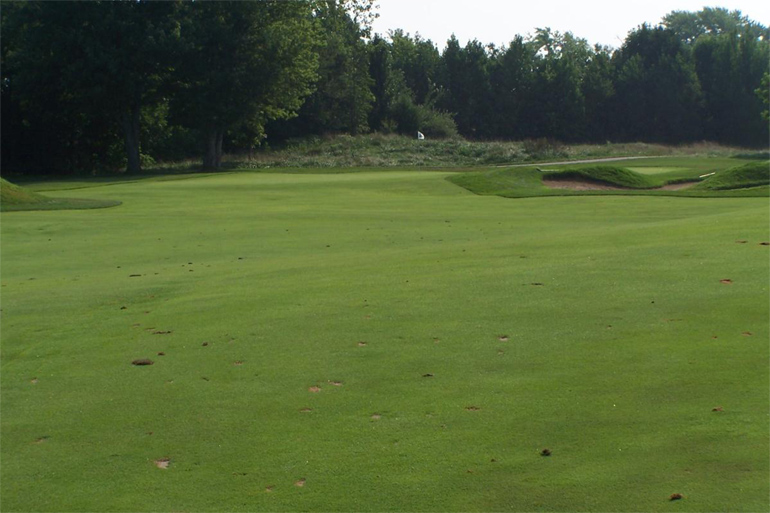
Those hitting driver to the narrow part of the fairway get a good look at the flag, although with a poor angle to a back right pin.
#17 – par 3 (206/167):
The green of the one-shot 17th nestles up against a pond on the right. The green is about 50 yards deep, yielding a variety of pin-positions and therefore, club selections. The author can recall using anything from a 9-iron to 3-iron, giving day-to-day variety to the hole. The left side of the green has several large mounds and swales, and is raised relative to the right side. Shots landing on this portion (especially with a left-to-right shot shape) will funnel toward the center of the green. However, missing just left will kick the ball further left and down to a collection area below the level of the green, leaving a difficult chip from a tight lie back towards the water. The right side of the green is much flatter and will leave an easier putt to center hole locations, but the water must be challenged on the tee shot. A small bunker back left awaits long, pulled shots for those thinking about the water during the swing.
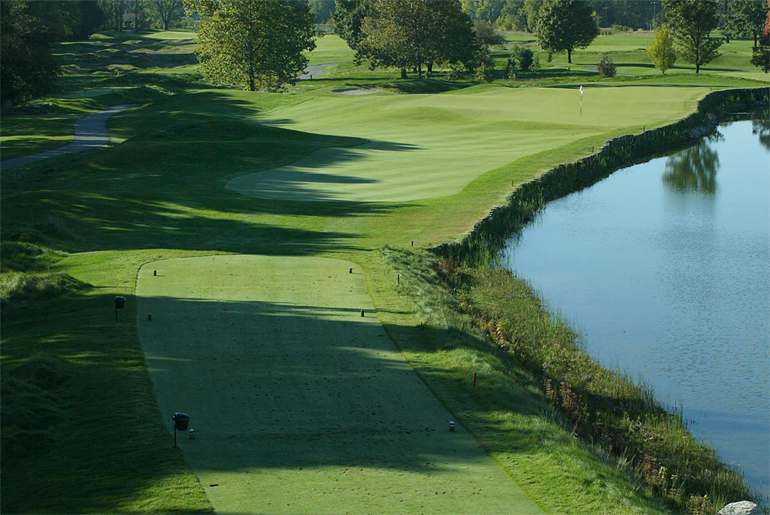
From above the tee, one can see the mounds and swales on the left portion of the green and the small bunker back left.

Those bailing out left are left with this difficult shot over the mounds, with water waiting on the other side of the green.
#18 – par 4 (484/415):
Like many of Dye’s courses, the 18th is perhaps the most difficult test of the day. Another switch-back hole, a right-to-left shot is preferred off the tee while the approach should be left-to-right. A large waste bunker guards the left side of the fairway and must be challenged for those wanting a better angle to the green. The green complex is the highlight of the hole. The green is pushed up with a large, deep bunker system on the right side. Like many of the holes, tightly mown collection areas below the level of the green await shots missed short, left, and long.

From the right side of the fairway, the difficult angle to the green is clear, with a terrifying group of deep bunkers awaiting shots short and right.

From behind the green, the swales and mounds one must negotiate if missing long or left are visible.
The three most common weaknesses of the course the author hears from critics are as follows: 1) The course is not very pretty 2) There is too much tall grass, and 3) Every driving hole is the same with a large waste bunker on one side of the fairway. It is difficult to argue against the first two points. The course has hard edges, brown sand, and rough waste areas that are not particularly pleasing to the eye. However, beautiful views across the celery bog are still afforded on several holes, and were improved by the removal of trees to the left of the 13th and 14th holes a few years ago. The rough at Kampen is thick, and even when not tall, provides a stern challenge. Most complaints stem from the tall heather, which is in play on many holes. Although there is still plenty of room to play and the heather is only an issue on significantly offline shots, chances of finding a ball in it are not good. However, the course is meant to be a difficult test, and many of the complaints would be avoided by the appropriate selection of tees.
The last point is one which can and should be argued against, as each hole provides its own unique challenge even though 13 of the 14 driving holes do contain a large fairway bunker. While Kampen is clearly not on the same level as The Stadium Course or the Ocean Course, both of these have similar types of fairway bunkers, and Dye implemented many of the same strategic elements from these into Kampen. Holes such as the 1st, 7th, 8th, 12th, and 15th highlight the individuality of each.
Kampen provides the golfer with not only a physical test, but a mental test as well. Those finishing with a good score will know both their swing and mind were in solid form. Kampen is a strategic gem, with options and angles dictating play throughout the round. The large greens and ever-changing northwest Indiana winds make it a joy to play from day to day. The many secrets of Kampen take many a round to fully uncover. If ever in West Lafayette, IN, make a point to visit the Birck Boilermaker Golf Complex and play one of the finest university courses in the nation.

















